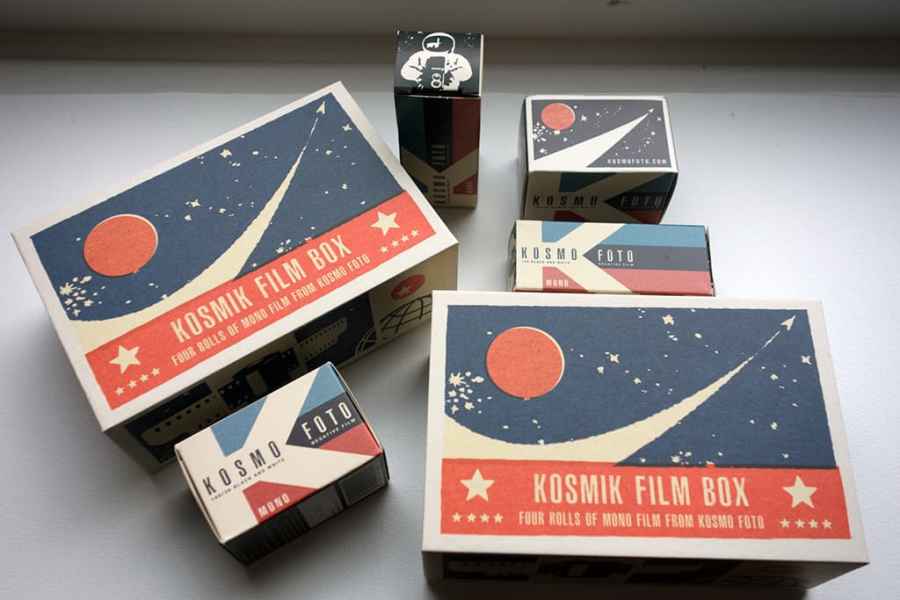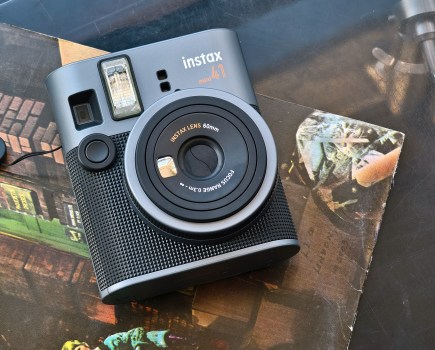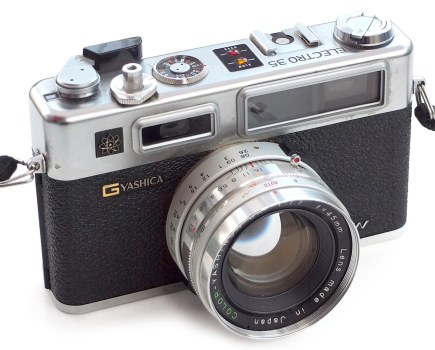Mike Crawford explores the growing trend of converted film stock, the companies that manufacture and distribute them, and why
As a film photographer I find it reassuring that there is still a healthy catalogue of both black & white and colour films available from the leading manufacturers. Indeed, Ilford, Foma, Adox and Kodak have either brought out new products or re-introduced previously discontinued lines in recent years. What has also been noticeable is the rise of smaller brands that either market films produced by other companies, convert existing film stock or even produce their own films.
Often classed as ‘boutique’, there is a surprising number producing a variety of different films. Most can be found at specialist online shops such as AnalogueWonderland.co.uk and PhotoBite.uk, including films from CatLABS, revolog, dubblefilm, Street Candy and Yodica amongst the more well-known names. For this article, I spoke to three very different companies based in the US, UK and France, as well as trying out several of their films.
While all emphasised the importance of distribution, marketing and being part of an analogue community, all had very different and fascinating stories behind their brands.
CineStill : Brian and Brandon Wright
Los Angeles-based photographers, the Wright brothers have worked in both motion picture and still photography. They started CineStill in 2012 with the ambition to make high-quality cine film available to photographers. See cinestillfilm.com Instagram: @cinestillfilm
In a relatively short time, CineStill has become an important and exciting brand in film photography. Through collaborations with manufacturers such as Kodak, brothers Brian and Brandon Wright have successfully produced and marketed a collection of films, bringing motion picture film to still photographers.
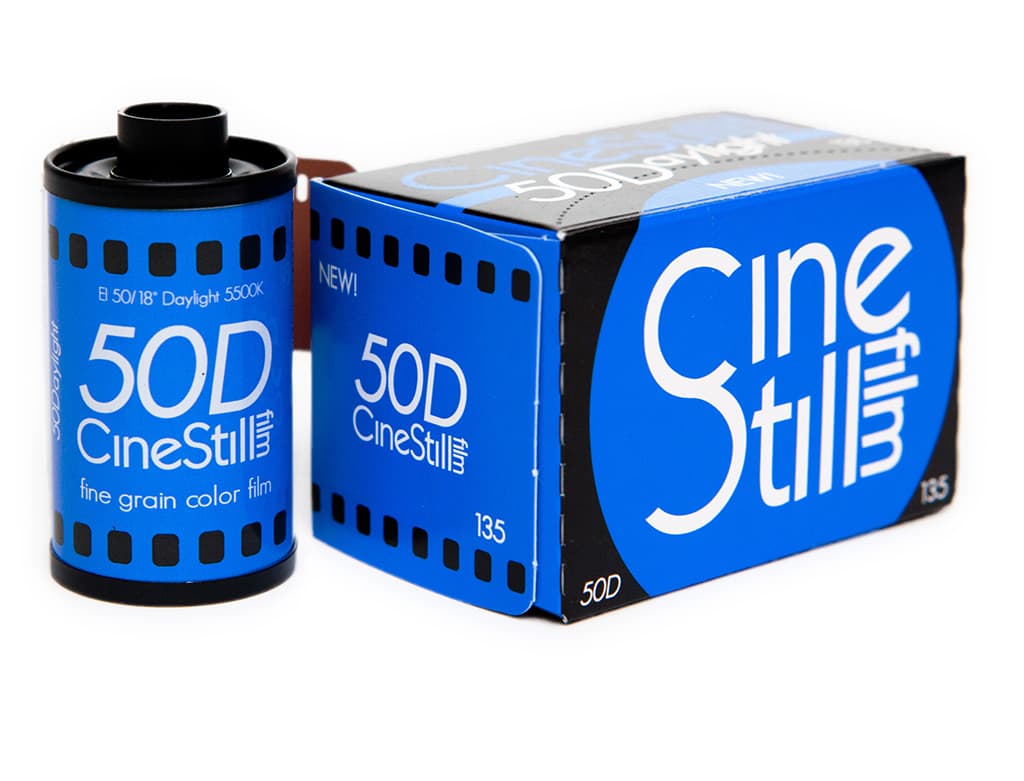 Over Zoom, I caught up with Brian and Brandon in Hollywood and CineStill’s head of marketing, Steve Carter, in Rochester, NYC.
Over Zoom, I caught up with Brian and Brandon in Hollywood and CineStill’s head of marketing, Steve Carter, in Rochester, NYC.
‘We started this company as photographers, so that we could have access to cine film technology,’ Brian opened. ‘Originally it was for ourselves, shooting on a Nikon 250 exposure back, which was long enough to go through a motion picture processing machine at 10 metres.’
While cinematic film is exactly the same size and format as used in 35mm still cameras, colour film cannot be processed in normal C-41 chemistry as it has an extra backing layer called Remjet. This is a carbon-based anti-halation and anti-static layer that also provides scratch protection when being run through a 35mm cine camera.
If processed at a conventional colour lab, the Remjet will contaminate the developer. It was important to find a safe method for its removal. ‘We wanted to make it compatible with C-41. It took a few years and tens of thousands of feet of wasted film,’ recalled Brian.

CineStill 800T As so much cinema film production is shot under studio lights, a film balanced for tungsten is essential. With a high ISO, 800T can be push processed several stops, giving natural skin tones under interior, artificial lighting. If used in daylight it will render a cold colour cast unless a warming 85B filter is used CineStill 800T. Picture credit Marti Vince Alonzo
Boutique from the beginning
‘Taking a finished 35mm emulsion and changing it is tough without compromising and without damaging the emulsion,’ confirmed Brandon. ‘We first made small batches, spooling it by hand, so very boutique from the beginning,’ Brian told me. ‘We then made a small machine that could run a thousand feet at a time.’
Eventually they were able to safely prepare large quantities of colour motion-picture film. These films, based on Kodak Vision 3 emulsions, each have unique properties. 50D is balanced for daylight and is considered the finest grained colour film currently available, while 800T is used for shooting under artificial light, giving a smooth tonal range and relatively fine grain for its speed.
Both films are available in 35mm and 120 as is their black & white film, BwXX, which is the classic Kodak Eastman Double-X movie stock. ’We are now working at a much greater scale as we have moved into mass production through collaborations,’ said Brian.
‘Most major analogue photography manufacturers are keen to work with us, as they often have extra capacity and can see we are opening up the market, so we are not a direct head-to-head competition.’
Lots of opportunities
Brandon considered the rise in boutique films in recent years and what makes theirs stand out. ‘It’s a niche but growing industry with room for new films. Manufacturers we work with in finishing and packaging see that too. More options are going to invigorate the customer.
With CineStill, the main value is that motion picture film has a different style. It works better in certain situations, especially 800T in artificial light, but can also create a unique look in daylight.’ Much of this growth has unsurprisingly been through the rise of social media which they see as paramount to a growing brand like themselves.
‘We would not have reached a worldwide market in a pre-digital world without the internet and Instagram,’ remarked Brian. ‘It sounds counter-intuitive for an analogue company, but it enables us to be more accessible and while not a household name, CineStill became recognised as “that new film,” within a year or two of starting.’
Steve mentioned how this interest in their film has helped secure worldwide distribution deals. ‘We have dealers and partners all over the world. Europe is an amazing market, and our second biggest after America, while Asia is burgeoning with a lot of demand.’
He also pointed out how it is being used more by professional photographers. ‘I see so many beautiful images that are shot on our films. It is getting more popular in the US, seeing CineStill used commercially on album covers and in advertising campaigns.’ For Brandon, it is important to offer more possibilities to the film community. ‘We want to release more products for photographers to make analogue photography more fun and accessible. We have home developing kits, are in partnership with Jobo and are making tools that improve the process and workflow which definitely go beyond just motion picture film.’

CineStill 50D. Based on Kodak 50D motion picture film, one of the most popular emulsions used in Hollywood, CineStill 50D is considered the finest grained colour negative film available today. It has a smooth tonal range, wide exposure latitude and is optimised for both optical RA4 darkroom printing and scanning Mamiya 6, CineStill 50D. Picture credit Mike Crawford
An inspiring process
Brian agreed that while they have grown as a company and brand, it is important to keep the character of CineStill intact. ‘As long as we stay boutique, we can do boutique things; it doesn’t have to appeal to everybody. We are not hand rolling it in the dark any more, instead using contract finishing for packaging, but this increases the level of quality.’
He concluded with the sense of pride they all have for their film. ‘Making it available to other people is a real joy at the end of the day. Seeing other people’s work has been awesome. It’s inspiring and makes me want to go out and shoot.’
Kosmo Foto: Stephen Dowling
Stephen Dowling came to the UK from New Zealand in 1994 working initially as a music journalist and is now a science editor with the BBC. An interest in Soviet cameras prompted him to start the website Kosmo Foto which in turn led to his own brand of film. See kosmofoto.com Instagram: @kosmofoto
The inspiration for Stephen Dowling to start his own brand of film, named after his analogue photography blog, Kosmo Foto, initially came from a friend and fellow blogger based in Tokyo. ‘Bellamy Hunt from Japan Camera Hunter unveiled his film, Streetpan 400, in 2016,’ Stephen told me over a Skype meeting.
‘I was blown away by the idea of launching a brand of film through a blog. I later admitted to Bellamy that he had inspired me to do exactly the same. ‘He said he could tell me all the mistakes not to make, though I still made a fair few on the way!’
Stephen then looked at the possible companies which might take an existing emulsion and provide a third-party re-brand. ‘It’s not as straightforward as it seems. ‘Some will do it, but it can be difficult to find the right people to speak to.’

Kosmo Foto Mono 35mm
Cold war stylings
After many enquires, he established a good relationship with Foma Bohemia in the Czech Republic, who have been producing photographic film since 1921. ‘I had already been shooting their film for years, so it was relatively straightforward from there. The minimum order was 2,500 rolls, which is small compared to others, though there are more upfront costs to consider such as packaging.’
To give his film, Kosmo Foto Mono, an individual identity, Stephen considered ideas for packaging, drawing inspiration from his interest in Soviet and Eastern European design from the Cold War era. ‘I’ve travelled in the former USSR and Eastern Europe, so have built up a collection of their graphic design. It was a way for avant-garde art ideas to come in under the cloak of propaganda and even now it still looks very fresh and bold.
I had the idea of rockets against a starscape; strong, offset graphics and knew an amazing designer, Martin Duncan, who goes by the name of My Mate Does Art. He got my references exactly.’ While Duncan’s design has changed over time and the packaging is now in its third iteration, it has had a strong and positive reaction within the analogue community.
‘The first batch of 2,500 sold out in two months, and I soon ordered another batch and another and so on.’ Distribution is very important to all brands of boutique films and Stephen has built up a large and impressive network since launching the film in 2017.

Kosmo Foto Mono is a very traditional, classic black & white 100 ISO film with a good tonal range which responds well to changes in exposure and processing time. A lower ISO and reduced development time will soften the contrast while increasing the rating and extending development will give higher contrast negatives. Mamiya 6, Kosmo Foto Mono. Picture credit Mike Crawford
‘Private customers can buy film and exclusive products such as T-shirts and gift boxes direct from my online shop, otherwise the film is available to retailers via distributors. In the UK, Analogue Wonderland, The Photographers’ Gallery and Aperture stock Kosmo film as well as other online shops.
Maco Direct is exclusive for the German market although they do also sell all over Europe, while two Spanish distributors cover Spain and Portugal. Freestyle is there for the US market while I have another distributor for Asia, though I also deal personally with shops worldwide and can supply new online film retailers.’
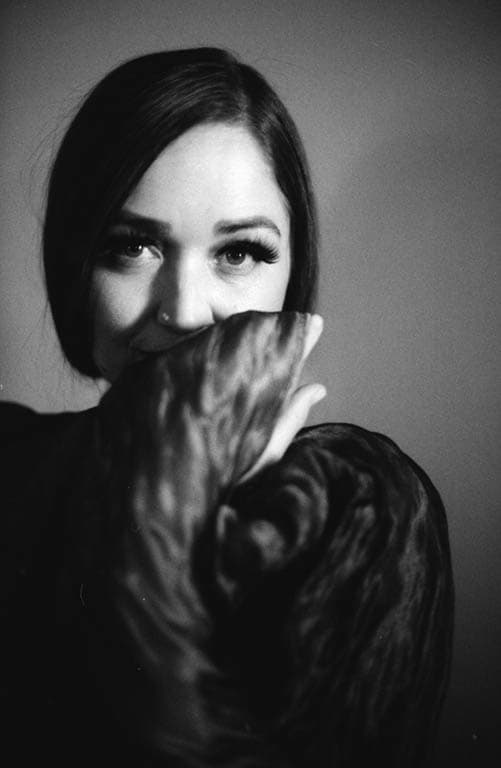
Kosmo Agent Shadow. The soon-to-be-released second film from Kosmo Foto is a 400 ISO black & white emulsion with potential for push processing up to 6400 ISO. Picture credit Roxanna Angles.
Agent shadow
Further requests for distribution have come from several South American countries and he is currently in discussion with a distributor for Kazakhstan and other parts of Eastern Europe. However, Stephen has also been working on ideas for new products and recently announced a Kickstarter campaign for his second film, Agent Shadow, which runs until 20 July.
‘I’m collaborating with another manufacturer on a film-noir themed film. It’s rated at 400 ISO but is pushable to 6400, so good for night shoots and documentary street work.’ Martin Duncan is again responsible for its design and visual identity and is being launched with what is probably a first for photographic brands, a graphic novella designed by Duncan titled The 36 Frames featuring the character of Agent Shadow.
Stephen sees such options and possibilities to create Kosmo products with different visual styles and designs as a bonus for his films. ‘With the big companies, corporate branding such as colour schemes and typefaces have to be consistent while I have more freedom to give each film a different personality.’
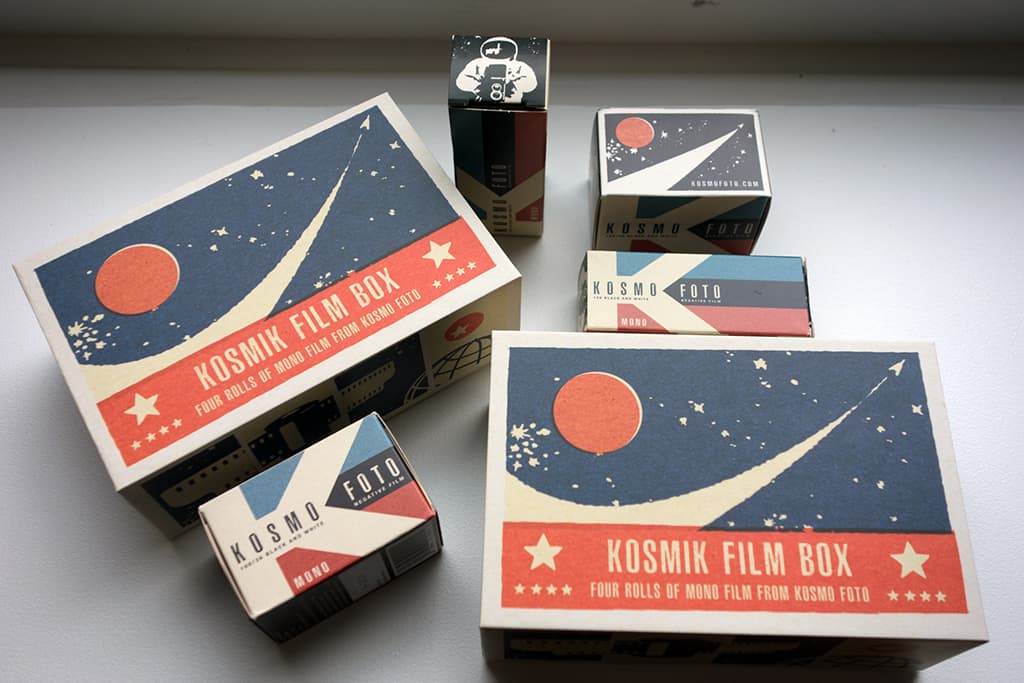
Kosmo films are known for their innovative artwork and packaging designed by Martin Duncan, giving each brand a separate identity and character
Film Washi: Lomig Perrotin
Lomig Perrotin founded Film Washi in Paris in 2013. The company is named after his first venture into film production, hand coating emulsion onto Japanese Washi paper. Now based in Brittany, Lomig produces a variety of creative, specialist films. www.filmwashi.com Instagram: @film_washi_official
Film Washi proudly calls itself the ‘World’s Smallest Film Company’ and has built a strong following in less than ten years for its intriguing range of individual films. I spoke to Lomig Perrotin about his background and the growing range of Film Washi products.
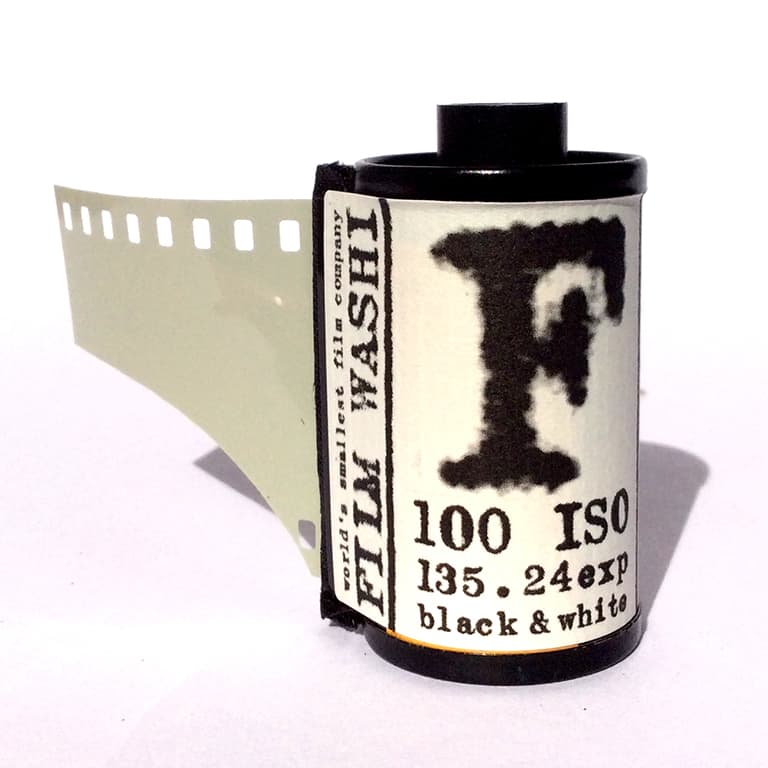
Both Washi 35mm and 120 films are produced using recycled film cartridges, spools and backing paper
‘I actually trained as a forester in Scotland, in the protection of the natural environment,’ Lomig began, ‘though my father was a camera collector, so I fell into photography at a young age.’
There are two distinct sides to his production. ‘Half fall into the category of boutique film, which I source from other producers and suppliers; kilometres of state-of-the-art, factory-coated film that are not available on the commercial market, which I convert for regular use.’ His other films, Washi W and V, with which he established his brand, are coated by hand onto Japanese papers.
‘I started with 50 films at a time, but the workflow is now more efficient for just one person working, and I now start at a minimum of 150 rolls going up to 300.’ Their origin was in experiments with paper negatives for a photographic project in 2012. Lomig found there was a great deal of interest in the film after sharing his work online.
‘People were contacting me wanting to try this film, and two photographic shops in Paris asked about selling it. It came to the point where I had the product, customers and two distributors.’ He added, ‘I was not sure if it would work, but it started to grow, expanding the range and meeting new distributors at Photokina such as Mirko from Fotoimpex in Berlin.’
In 2015 Lomig and his wife moved from Paris to Brittany having worked full time in a photographic lab while also running Film Washi. ‘I had two full-time jobs, so when we came to Brittany, it allowed me to have a better space to work. I had started in a closet in our Paris apartment, then continued in a garage.’
His next workshop was an inspired and ideal choice. ‘I found a shipping container which had been a French army mobile darkroom plus a smaller one for an office.’

Washi S. A very high contrast 50 ISO emulsion with fine definition and very low grain used by the film industry for optical sound recordings on motion picture film. ‘I think the brutalist architecture of London’s Barbican Centre was an appropriate subject for this very interesting and distinctive film.’ says Mike. ‘The texture of the concrete seems etched into the emulsion of the film, (available in 35mm and 120), and am already considering what future project I can use it for.’ Konica Hexar, Washi S. Picture credit Mike Crawford
Hand made
I was interested in what machinery Lomig uses to coat his films. ‘That is easy to answer as it’s my hand! For Film W and V, each film is coated individually though I did source some older machines like a 35mm perforation cutter which was originally from the Forte factory in Hungary.’
Other equipment, such as a film slitter and cartridge spooler he has built himself.
Besides these hand-crafted films, there is his range of Washi films using specialist and technical emulsions.
‘Film F is a really unique X-ray film with no anti-halation layer, so light is diffused where it strikes the film giving a very ethereal feel that transforms reality.’ Film Washi’s website states that their ethos is based on ‘innovation, simplicity and ecology’ which is seen in their use of recycled film cassettes, spools and backing paper, at least for most products.
‘The S120 is a high-contrast motion picture sound recording film. I had previously bought a lot in 35mm, but then had it supplied cut for 120. The first 1,000 rolls I spooled myself, but later used another factory for the next 5,000, which were rolled with brand new backing paper.’
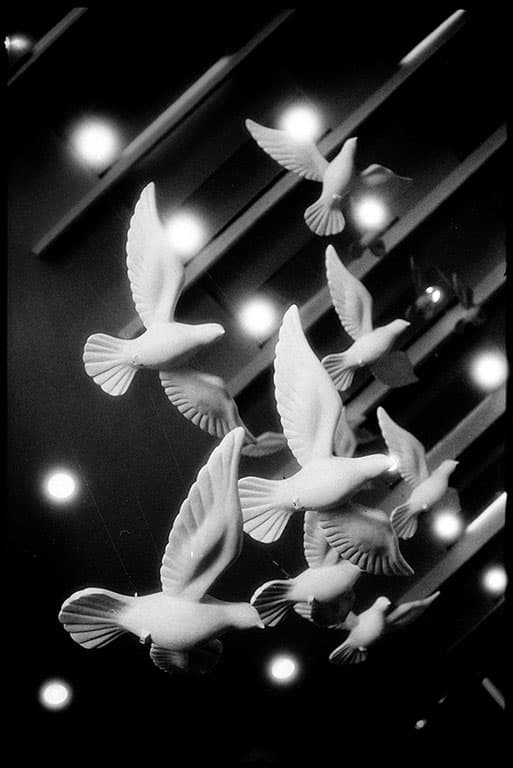
Washi F. Washi F is a Fluoride X Ray film, available in 35mm and 120 with no anti-halation layer, which provides glowing highlights and a natural diffusion combined with a pleasing granularity. Suggested rating is 100 ISO, testing is essential to determine the best speed depending on processing. I was impressed with the initial results and found it worked well at 200 ISO Konica Hexar, Washi F. Picture credit Mike Crawford
Community spirit
Similar to CineStill and Kosmo, Lomig sees the importance and strength in a like-minded community. ‘No player has a whole production line from start to finish. We are all connected and most of us speak together.’ I asked Lomig how he sees the next few years.
‘I was surprised by the success of some products. I’m not sure what Film Washi will be like in five years, if the projects will be the same or changed. I certainly have ideas for machines for better production, though last year I spooled all kinds of films, 18,000 rolls in total. I make a living from Film Washi which is already an unexpected dream, though I don’t have time for my own photography any more.’
However, Lomig concluded with the satisfaction he feels seeing how his film is used. ‘I sometimes see a photo, and never could I have imagined that it could have been with a Washi film. That makes me way happier than taking my own pictures and hope that it will continue.’

Washi W. The initial Washi ‘film’ is hand coated onto textured Japanese paper and is an orthochromatic emulsion available in 35mm, 120, 620 and various sheet sizes. It needs careful handling during processing and can either be scanned and inverted or printed conventionally in a darkroom which will emphasise the texture and fibres of the paper base. Picture credit Mike Crawford

